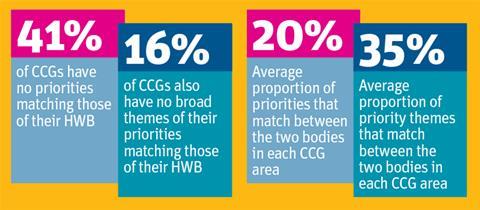HSJ analysis has revealed a gulf between the stated aims of clinical commissioning groups and council hosted health and wellbeing boards, with the two organisations sharing no priorities in two-fifths of CCG areas.

HWB stats
The finding is based on analysis of the most recent strategies of health and wellbeing boards − the newly created forums in which health and care leaders come together − in 50 areas and the stated priorities of 61 corresponding CCGs. The research covered both the areas where the two types of organisation have identical boundaries and those where boundaries differ.
As well as examining the priorities themselves, the work also compared the wider themes of each CCG’s priorities to those of its HWB. It found:
- Of the CCGs, 41 per cent had no priorities matching those of their HWB.
- Sixteen per cent had no priorities with matching themes.
- The average number of matching priorities between CCGs and their HWB was one, and the average number of matching priority themes was 1.6. The average number of priorities was 6.3 per HWB and 6.4 per CCG.
Several organisations and commissioning leaders told HSJ that CCGs and local authorities could have strong working relationships despite not sharing priorities, and that the majority were working well together.
Others said the pattern reflected difficulty working together, making it harder to commission effectively or redesign services.
The analysis comes as HWBs − whose membership comprises representatives of councils, CCGs, and other organisations in each area − are winning an increasingly prominent role. They are expected to be in control of the forthcoming integration transformation fund for their area. This pooled budget, announced in June and largely funded from CCG budgets, will be worth £1.1bn nationally in 2014-15 and £3.8bn in 2015-16.
HSJ understands NHS England is considering requiring CCGs to produce strategic plans for 2014-16 according to their HWBs’ areas, as well as for their own patch. This would mark a further step towards joint planning between the two bodies and could force CCGs to work together in areas where several lie within HWB boundaries.
One NHS England local team director told HSJ there was difficulty in their area, where some CCG and HWB boundaries do not correspond, in ensuring they worked together and agreed commissioning plans. The source predicted “argy-bargy” between CCGs and councils as they sought to agree use of pooled funds.
Association of Directors of Social Services president elect David Pearson said: “Although there was a lot of work [between CCGs and local authorities] before April, it is early days for CCGs as statutory bodies.
“Nationally the progress made with relationships and understanding priorities is better than people had hoped.”
HSJ has been told of problems agreeing priorities in areas where HWBs cover the area of several CCGs, which themselves have different plans, or where boundaries cross.
However, Mr Pearson said changing structures - for example merging CCGs to match HWB boundaries − was not a priority.
He said: “Issues such as sovereignty and organisational boundaries are always present. We need to overcome such barriers to make progress in integrating and improving services.”
HWBs’ increasing role in joint planning has sparked concern among some commissioners about the boards’ readiness, and calls for a comprehensive national assurance process.
Cathy Winfield, the joint chief officer of four CCGs in Berkshire, said: “To date there has been little attention paid to the development of these boards. I think they could benefit from a national focus on how they are being developed and how they are supported. If we are going to put weight behind them it is important they are equipped for their role and have the confidence of the wider system.”
NHS Clinical Commissioners leadership group joint chair Steve Kell, a GP and chair of Bassetlaw CCG, acknowledged HWBs’ “star was rising” and said there was “variation in terms of [their] structure and readiness”.
“We are coming to a critical time. What is really important is HWBs have a limited number of priorities they are going to deliver, and focus on what can be achieved from working together,” he said.
“I don’t think CCGs welcome the end point being HWBs having total control, but we do see ourselves as equal partners.”
Proportion of the total priorities in 50 HWBs and 61 CCGs’ strategic and commissioning plans
Local authorities’ top 10 priority themes
Early years: 8.4%
Children or young people: 6.3%
Choosing to live healthily: 6.3%
Older people: 6.3%
Mental health: 4.7%
Inequalities: 4.7%
Prevention: 4.2%
Care of long term conditions: 3.7%
Integration: 3.7%
Obesity: 3.7%
CCGs’ top 10 priority themes
Long term conditions: 7.8%
Emergency or urgent care: 7.8%
Mental health: 7.8%
Efficiency/finance/value: 5.9%
Integration: 4.5%
Elective care: 4.3%
Primary care: 4.0%
Children or young people: 3.5%
Community services: 3.5%
Quality: 3.5%
Additional reporting: Sam Jackson and Ime Eka



























17 Readers' comments